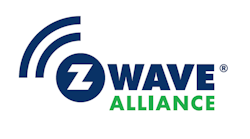Special Focus: Monitoring--Z-Wave, All the Rage
Z-Wave has a prominent presence in the home automation industry. Scores of products in a wide spectrum of end-user areas—lighting, locks, heating, home entertainment—employ Z-Wave technology as the foundation of their operation.
There is no area, however, where the use of Z-Wave technology is more prevalent than in the security industry. By far, Z-Wave's market presence dwarfs all other technologies, as the vast majority of the companies that manufacture panels have selected Z-Wave as their lifestyle technology of choice, including such security-industry heavyweights as Honeywell, 2GIG, ADT, Napco, Ingersoll-Rand and Alarm.com, to name just a few. In fact, greater than 80 percent of the North American security company-based lifestyle solutions are powered by Z-Wave.
SD&I magazine wanted to find out the latest information on Z-Wave technology, so we went to Mark Walters, chairman of the Z-Wave Alliance, to get caught up. Here’s what Walters had to say.
Q. Tell us about the Z-Wave technology and its recent accomplishments?
A. Z-Wave is a low-power, wireless communications technology that has been developed specifically for control and status applications, such as remote home control and monitoring. Thanks to its versatility— it is the only control protocol that is interoperable between brands— Z-Wave has emerged as a key enabling technology.
Z-Wave uses a technique called mesh networking, by which any device in the home can act as a relay station to another device, with two-way communications. This ensures reliable, whole-home coverage, with no blind spots caused by common household obstructions. Also, Z-Wave works in the 900MHz spectrum, so there is no interference with other household wireless technologies such as Wi-Fi, Bluetooth or popular wireless speakers and video systems.
Z-Wave has become the wireless technology of choice for the security industry, with the lion’s share of the U.S. market. This industry is currently among the key drivers of residential automation and control, with offerings from service leaders such as ADT, Honeywell and Vivint and lock leaders like Yale, Kwikset and Schlage. The success that Z-Wave has enjoyed in this channel has inspired other business sectors to follow suit. Z-Wave is also a key component of the Verizon Home Control System, the new AT&T Digital Life system and the Lowes Iris system. Z-Wave is also an International standard, with an extensive European presence and frequencies approved in key global markets such as Brazil, Japan, Russia and India.
Q. What is making this technology so attractive to manufacturers and users?
A. The key to Z-Wave’s adoption by the vast majority of the security industry's lifestyle solutions is its large ecosystem of certified interoperable products. Z-Wave has over 800 products from over 100 different manufacturers, with all of them interoperable and backward-compatible with each other. No other technology comes close to this kind of extensive ecosystem. Businesses and their customers want to know that they have choices when selecting products and that they are not tied to the success and business plans of any one supplier.
Q. How does Z-Wave technology compare/contrast to Wi-Fi technology or even Bluetooth or Near Field Communications?
A. Unlike other household wireless technologies, Z-Wave is optimized for home control. Its bandwidth, efficiency and low power consumption have been specifically designed for these applications. As an example, battery-operated Z-Wave devices, such as security sensors, can last for years without a battery change.
Wi-Fi, on the other hand, is optimized for high bandwidth, high-power data transmission using a server-client topology. Wi-Fi can be used for home control, but requires too much energy for battery-powered devices and is subject to unreliability through traffic jams in homes with multiple Wi-Fi devices, which are common. Bluetooth is optimized for short-range, high-bandwidth, one-to-few topology. It doesn’t have the range or network size for home control. Near Field Communication (NFC) is optimized for very short range; a foot or two and one-to-one topologies. There is nothing wrong with these other technologies, but they serve different purposes than Z-Wave.
Q. What is Z-Wave doing to ensure its industry leadership position now and in the future?
A. Z-Wave continues to expand on its protocol features, making network creation easier and the mesh network faster and more resilient. We continue to see more manufacturers adopt the technology, bringing new device types and lower prices to the market. The Z-Wave Alliance is also working on an on-line training program to teach installers how to maximize their returns when using Z-Wave technology.
Q. What might be coming in the near future as far as technology updates, new alliances, etc?
A. Z-Wave recently added new multi-channel, higher bandwidth, lower power, larger memory transceiver modules from Sigma Designs. These improvements take advantage of integrated circuit advancements and provide new options for manufacturers and products without raising costs. These new modules also allow for the adoption of Z-Wave in new countries like Taiwan, China and Korea. Of course, in keeping with our interoperability credo, all these new features remain fully backwards- compatible with all existing Z-Wave products.
The Z-Wave Alliance is also very active with the Smart Grid and is a member of the NIST Smart Grid Interoperability Panel (SGIP). We continue to participate with SEP, OpenADR and IoT alliances and working groups. We are working with several universities on studies involving the use of home control technology to help people who need assistance to live more independently.
The market has already seen Z-Wave capture key market drivers like security providers and telcos. We expect that additional industries where Z-Wave is already well-represented, such as healthcare, energy and hospitality, will continue to broaden our leading ecosystem as the IoT becomes mainstream technology.



